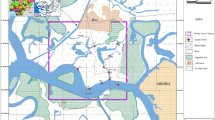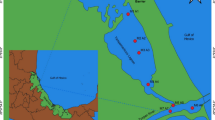Abstract
Polycyclic aromatic hydrocarbons and polychlorinated biphenyls were investigated in sediment of bitumen deposit impacted area of Agbabu, Nigeria, to determine the present level of contamination with these toxic compounds prior to exploitation. Samples were collected during the dry season (March) and the wet season (August) of year 2008. Analysis was carried out with gas chromatography using mass spectrometry detector for polycyclic aromatic hydrocarbons and flame ionization detector for polychlorinated biphenyls. In the dry season sum of concentration of PAHs ranged from zero to 0.12 ± 0.06 ppm, while in the wet season the minimum was 0.18 ± 0.07 ppm and the maximum was 1.04 ± 0.16 ppm. Most of these values were higher than sum of polycyclic aromatic hydrocarbons concentrations of 1–10 μg/kg indicating that they were likely to come from anthropogenic sources. Average concentrations of PAHs such as naphthalene and benzo (a) pyrene obtained in sediment in the wet season in some of the stations were higher than recommended limits. The linear regression analysis between sum of concentrations and percentage organic carbon showed no significant correlation in sediment in the dry season (r2 = 0.0025) and in the wet season (r2 = 0.1345). The predominance of 4–6 ringed polycyclic aromatic hydrocarbons and the ratios between pairs of individual polycyclic aromatic hydrocarbons showed that they are likely to have come from pyrolytic sources. No polychlorinated biphenyl congener was detected in the samples.
Similar content being viewed by others
References
Abass, A. A.; Abass, O. A.; Adejare, A. A.; Ojeyemi, M. D., (2007). Distribution of polycyclic aromatic hydrocarbons in surface soils and water from the vicinity of Agbabu bitumen field of south-western Nigeria. J. Environ. Sci. Heal. A., 42(8), 1043–1049 (7 pages).
Adebiyi, F. M.; Asubiojo, O. I; Ajayi, T. R., (2006). Multi-elemental analysis of Nigerian bitumen by TXRF spectrometry and the physical constants characterization of its hydrocarbon content. Fuel., 85(3), 396–400 (5 pages).
Adewole, M. G., (2010). Environmental implications of bitumen seep induced pollution in parts of Ogun state, southwestern Nigeria. Environ. Earth. Sci., 59(7), 1507–1514 (8 pages).
Adeyemi D.; Ukpo G.; Anyakora C.; Uyimadu, J., (2009). Polychlorinated biphenyl in fish samples from Lagos Lagoon, Nigeria. Afr. J. Biotech., 8(12), 2811–2815 (5 pages).
ATSDR, (2001). Polychlorinated Biphenyls. Agency for Toxic Substances and Disease Registry, ATSDR web page. http://www.atsdr.cdc.gov/tfacts17.html
Akande, J. M., (2007). Environmental impact assessment of steam injection mining method of Agbabu bitumen deposit. J. Eng. Appl. Sci., 2(10), 1497–1500 (4 pages).
Bitumen safety data sheet, (2008). Review. IES-Italiana Energia E. Servizi, Strada Cipata 71 46100 Montova. http://www.tosas.co.za/msds/MSDS_PenetrationGradeBitumen.pdf
Ciecierska, M.; Obiedzinski, M., (2007). Canned fish products contamination by polycyclic aromatic hydrocarbons. Acta Sci. Pol., Tech. Aliment., 6(2), 19–28 (9 pages).
Clescery, L. S.; Greenberg, A. E.; Trussels R. R., (1989). APHA 6630c. Liquid-liquid extraction gas chromatographic method II. Standard methods for examination of water and waste water. 17th ed. American Public Health Association American water works Association, Water Pollution Control Federation, 6-170-6-181.
Davies, O. A.; Abowei, J. F. N., (2009). Sediment quality of lower reaches of Okpoka creek, Niger Delta, Nigeria. Eur. J. Sci. Res., 26(3), 437–442 (6 pages).
Edward, N. T., (1983). Polycyclic aromatic hydrocarbon (PAHs) in the terrestrial environment: A review. J. Environ. Qual., 12(4), 427–441 (15 pages).
Elaine, A. L.; Herman, H., (2000). Multicomponent Analyte Determination, Gas Chromatography — USEPA Method 8270.
Fact sheet sources of polychlorinated biphenyls, (2003). Oregon Department of Environmental quality.- http://www.deq.state.or.us/lq/cu/nwr/PortlandHarbor/docs/SourcePCBs.pdf
Fagbote, E. O.; Olanipekun, E. O., (2010). Evaluation of the status of heavy metal pollution of sediment of Agbabu bitumen deposit area, Nigeria. Eur. J. Sci. Res., 41(3), 373–382 (10 pages).
Fouial-Djebbar, D.; Badjah Hadji Ahmed, A. Y.; Budzinski, H., (2010). Determination of organochlorine compounds in coastal marine sediments from the southern west of the Mediterranean Sea. Int. J. Environ. Sci. Tech., 7(2), 271–280 (10 pages).
Ho, H. H.; Swennen, R.; Van Damme, A., (2010). Distributions and contaminations status of heavy metals in estuarine sediments near Cua Ong harbor, Ha Long Bay, Vietnam. Geol. Belg., 13(1–2), 37–47 (11 pages).
Jonsen, R. J.; Lukas, Y. W.; Harms H., (2005). Principles of microbial PAH-degradation in soil. Environ. Pollut., 133(1), 71–84 (14 pages).
Juang, D. F.; Lee, C. H.; Hsueh, S. C., (2009). Chlorinated volatile organic compounds found near the water surface of heavily polluted rivers. Int. J. Environ. Sci. Tech., 6(4), 545–556 (12 pages).
Kyn, B.; Maung, A. T.; Begum, B.; Haque, M.; Hemalika, S.; Sudrajat, H., (2009). Remediation of polycyclic aromatic hydrocarbons polluted soil using Fenton’s reagent. J. Appl. Sci. Environ. Sanitation., V(N), 63–68 (6 pages).
Nagpal, N. K., (1994). Development of water quality and sediment criteria for PAHs to potent aquatic life. http://www.heb.pac.afo-mpo.ca/congress/1994/nagpal.pdf
Nnamchi, C. I.; Obeta, J. A. N.; Ezeogu, L. I., (2006). Isolation and characterization of some polycyclic aromatic hydrocarbon degrading bacteria from Nsukka soils in Nigeria. Int. J. Environ. Sci. Tech., 3(2), 181–190 (10 pages).
Oboh, O. B.; Ilori, M. O.; Akinyemi, J. O.; Adebusoye, S. A. (2006). Hydrocarbon degrading potentials of bacteria isolated from a Nigerian bitumen (Tarsand) deposit. Nat. Sci., 4(3), 51–58 (8 pages).
Okafor, E. Ch.; Opuene, K., (2007). Preliminary assessment of trace metals and polycyclic aromatic hydrocarbons in the sediments. Int. J. Environ. Sci. Tech., 4(2), 233–240 (8 pages).
Olajire, A. A.; Brack, N., (2005). Polycyclic aromatic hydrocarbons in Niger Delta soil contamination, sources and profiles. Int. J. Environ. Sci. Tech., 2(4), 343–352 (10 pages).
Olajire, A. A.; Olujobade, M.; Olabemiwo, O., (2008). N-Alkane distribution in soil and water samples collected near Agbabu bitumen field of southwestern Nigeria. Int. J. Environ. Stud., 65(6), 769–779 (11 pages).
Opuene, K.; Agbozu, I. E.; Ekeh, L. E., (2007). Identification of perylene in sediments: Occurrence and diagenetic evolution. Int. J. Environ. Sci. Tech., 4(4), 457–462 (6 pages).
Prycek, J.; Ciganek, M.; Srinek, Z., (2007). Clean up of extracts for intracid derivatives of polycyclic aromatic hydrocarbons analysis prior their gas chromatography determination. J. Braz. Chem. Soc., 18(6), 1125–1131 (6 pages).
Rajput, R. K., (2000). Engineering Materials, 2nd. Ed. S. Chand Company Limited, New Delhi.
Rauf, A.; Javed, M.; Ubaidullah, M.; Abdullah, S., (2009). Assessment of heavy metals in sediments of the river Ravi, Pakistan. Int. J. Agric. Biol., 11(2), 197–200 (4 pages).
Soltanali, S.; Shams Hagani, Z., (2008). Modeling of air stripping from volatile organic compounds in biological treatment processes. Int. J. Environ. Sci. Tech., 5(3), 353–360 (8 pages).
Teaf, C. M., (2008). Polycyclic aromatic hydrocarbons (PAHs) in urban soil; A Flourida risk assessment perspective. Int. J. soil. sed. water., 1(2), 1–15 (15 pages).
Zhang, H.; Dang, Z.; Zheng, L. C.; Yi, X. Y., (2009). Remediation of soil co-contaminated with pyrene and cadmium by growing maize (Zea mays L.). Int. J. Environ. Sci. Tech., 6(2), 249–258 (10 pages).
Author information
Authors and Affiliations
Corresponding author
Rights and permissions
About this article
Cite this article
Fagbote, E.O., Olanipekun, E.O. Levels of polycyclic aromatic hydrocarbons and polychlorinated biphenyls in sediment of bitumen deposit impacted area. Int. J. Environ. Sci. Technol. 7, 561–570 (2010). https://doi.org/10.1007/BF03326165
Received:
Revised:
Accepted:
Published:
Issue Date:
DOI: https://doi.org/10.1007/BF03326165




